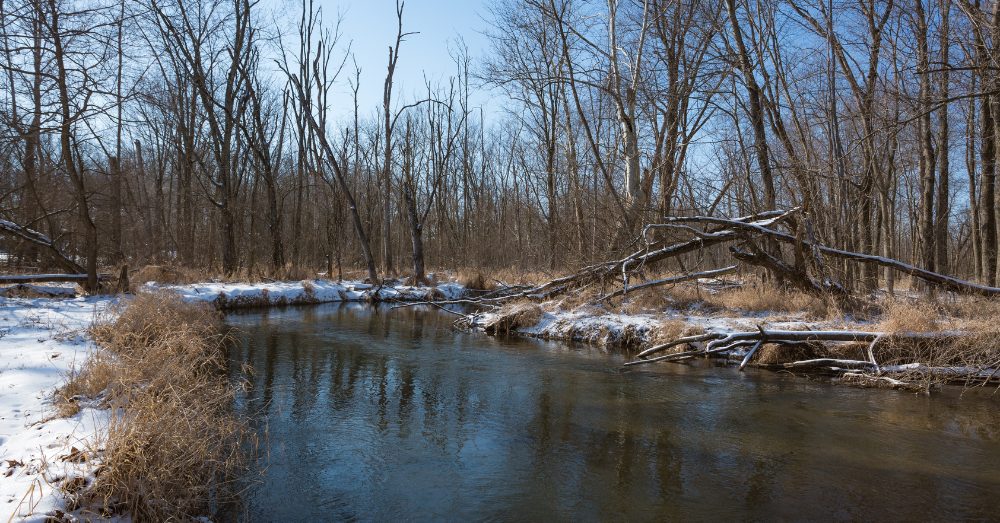Winter River Walks: Indiana’s Hidden Cold-Weather Beauty
Most people store their kayaks and wait for spring, but they’re missing something good. Indiana’s rivers change completely when temperatures drop, offering peaceful walks, clear views, and wildlife you won’t see during warmer months. The White River winds through charming towns where winter brings a quieter kind of magic to the water’s edge.
- Cold weather makes wildlife easier to spot along river trails since bare trees and sparse vegetation provide unobstructed views of deer, foxes, and winter birds
- Frosted riverbanks create scenery that rivals any summer day, with ice crystals catching morning sunlight and snow showing off the natural contours of the water’s edge
- Winter walking offers health benefits and solitude that crowded summer trails can’t match, giving you space to think and breathe without dodging crowds
Why Cold Weather Makes Better Wildlife Watching
Here’s what catches people off guard: you’ll actually see more animals in winter than summer. When leaves fall and undergrowth dies back, large mammals like deer stand out against snowy backdrops. Red foxes become particularly visible thanks to their bright fur against dull winter colors.
Birds are easier to track too. Winter resident species like cardinals, blue jays, and woodpeckers become more active around feeders and easier to photograph against bare branches. The lack of foliage means you can spot nests, identify tree species, and develop tracking skills that summer’s dense greenery would hide.
Frost and snow reveal mammal footprints along the banks. You might spot tracks from raccoons, foxes, or even river otters in the right conditions. Nature leaves you a roadmap of all the activity that happened overnight.
The White River’s Winter Appeal
The White River stretches over 25 miles through Hamilton County, and winter turns it into something completely different from the tubing destination it becomes in July. In Noblesville, IN, the White River Greenway offers almost three miles of paved trail connecting Potter’s Bridge Park with Forest Park in the downtown area.
Potter’s Bridge, a restored covered bridge dating back to 1837, becomes especially photogenic when surrounded by snow. The trail hugs the riverbank through woodland and prairie habitats, with rest benches at scenic overlooks where you can watch the water flow past frosted banks.
Forest Park provides a natural midpoint for winter walkers. The 150-acre space includes heated restrooms that become essential on cold days, plus parking and connections to other trail systems. You can walk as much or as little as you want, then warm up with hot chocolate from one of the downtown cafes nearby.
What Makes Winter Walks Different
The crisp air changes everything. Sound travels differently in cold weather, making bird calls sharper and the crunch of frozen leaves underfoot more pronounced. There’s a peacefulness to winter snowfall that summer can’t touch.
Fewer people wander the trails this time of year, which means you get the path mostly to yourself. No fighting for parking spots or dodging cyclists every ten seconds. Just you, the river, and whatever wildlife decides to make an appearance.
The water itself looks different too. Morning frost creates intricate patterns along the banks. Ice forms in interesting shapes around rocks and fallen branches. When sunlight hits these ice crystals, the whole riverbank sparkles.
Preparing for Cold-Weather Walks
You don’t need expensive gear, but a few smart choices make winter walks more comfortable. Good boots with traction are absolutely necessary since ice and packed snow create slippery conditions. Warm socks prevent the cold from creeping up through your feet and cutting your walk short.
Layer your clothing so you can adjust as you warm up from walking. Start with a moisture-wicking base layer, add insulation, and top it with a windproof jacket. Bring gloves, a hat, and a scarf even if it doesn’t seem that cold. Wind chill along the river can surprise you.
Water matters just as much in winter as summer. Cold, dry air dehydrates you faster than you think. Pack a thermos with something warm if you want, but plain water works fine.
A walking stick helps with balance on icy sections. Some people bring binoculars for bird watching or a camera to capture winter scenery. The nice thing about winter is you can pack more gear since you’re not sweating through your shirt.
Getting Out There This Season
Don’t wait for perfect weather. Some of the best winter walks happen on days that look questionable from your window. Bundle up, drive to your nearest river trail, and give yourself permission to turn back early if conditions aren’t right.
The kayaks will still be there in spring. Right now, winter is offering something different: quiet trails, clear views, and the chance to see your local river in a whole new way. Those frosted banks won’t last forever.


